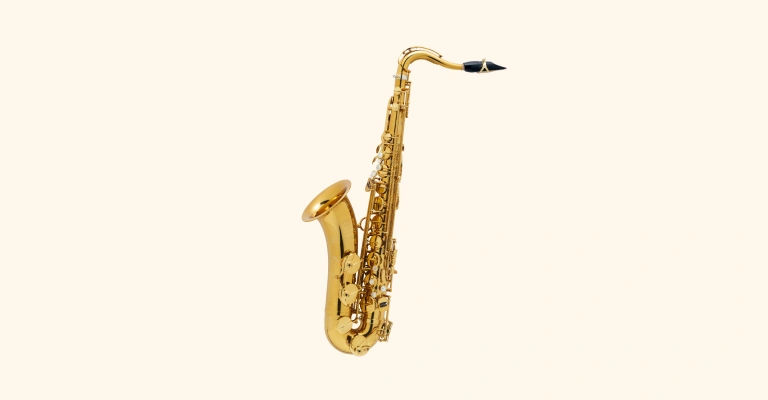Saxophones are iconic musical instruments known for their versatility and distinctive sounds.
We all know how saxophones look and their distinctive sound. But you might not know that there are different types of saxophones.
The cost of each sax type is different, they have unique sounds and characteristics. So, if you are starting now or want to know more about saxophone types, this is the article for you.
Before we dive in, here is the table that explains the difference between various saxophone types.
| Type | Pitch | Size | Range | Sound | Common Usage |
|---|---|---|---|---|---|
| Soprano Sax | Bb or C | Smallest | High | Bright | Classical, jazz, contemporary |
| Alto Sax | Eb | Smaller than tenor | Mid-range | Warm | Jazz, rock, pop, classical |
| Tenor Sax | Bb | Larger than alto | Mid-range | Deep | Jazz, rock, ensemble |
| Baritone Sax | Eb | Larger than tenor | Low range | Full body | Jazz, wind ensembles |
| Bass Sax | Bb | Larger than baritone | Low range | Rumbling | Experimental music, jazz |
What Are The Different Types Of Saxophones?
Here are all the major types of saxophones and useful information about each one you need to know.
1. Soprano Saxophone

Soprano saxophones, the smallest type of saxophone, have a high, bright, and piercing sound. It can be pitched in either B♭ or C, providing versatility in tuning. This saxophone type is a favorite among classical and jazz musicians.
Its distinctive timbre adds a unique flavor to contemporary and experimental music. Also, soprano saxophones play a crucial role in saxophone quartets, contributing to the ensemble’s harmonic richness.
Some famous musicians who played on soprano saxophone were John Coltrane and Sidney Bechet.
2. Alto Saxophone

Alto saxophones are a bit smaller than the tenor saxophones and the pitch is in E♭. It has a warm and expressive sound, which makes it a great choice for many different types of music.
This saxophone type fits well in jazz, rock, pop, or classical music. It’s also a good option for beginners because it’s not too big and the fingerings are easier to learn.
Charlie Parker and Paul Desmond played on alto sax and they created many unforgettable and tasty melodies.
3. Tenor Saxophone

The next type of saxophone is the tenor, which looks like an alto but is a bit bigger. The pitch of the tenor saxophone is B♭ and it has a rich and mellow sound.
Its deep and robust tones make it a staple in jazz and rock bands, often taking on lead roles in ensemble performances. Also, tenor saxophones work great as a solo instrument and add emotions to melodies.
Famous tenor saxophone players are Sonny Rollins, Lester Young, and Stan Getz among others.
4. Baritone Saxophone

Baritone saxophones, pitched in E♭, are larger and heavier than the tenor saxophone. A baritone sax produces deep and resonant tones, making it an essential instrument in jazz and wind ensembles.
Baritone saxophones provide a rich and full-bodied sound and add depth to the sound. Very often they are used as the foundation of bass.
Gerry Mulligan, Harry Carney, and Pepper Adams are a few players who are famous for playing baritone saxophones.
5. Bass Saxophone

Bass saxophones are the biggest and heaviest among all types of saxophones. They are tuned in the key of B♭ and are famous for a deep and strong sound that resonates through the music.
Although not commonly seen, you can hear them in jazz bands and experimental music. Bass saxophones add a unique low-end to the sound and songs.
Adrian Rollini is famous for playing on bass saxophone and Scot Robinson is known for reviving its use in jazz.
Other Saxophone Types
Saxophones listed above are the most popular and known types but there are other types of saxophones too.
For example, the sopranino saxophone is a very interesting-sounding saxophone type. There is a curved sopranino saxophone, which looks like an alto, and a straight sopranino, which looks like a soprano sax.
The soprillo or sopranissimo saxophone is the smallest type. When I first saw it when I was a kid, I thought it was a big clarinet. It was developed in the late 1990s by Benedikt Eppelsheim and it’s pitched octave above the soprano saxophone.
Contrabass saxophones are low-pitched types and a big one as well. However, the biggest member of the saxophone family is the subcontrabass saxophone and it’s pitched lower than the bass saxophone.
Conclusion
I hope you found this post useful and learned more about the types of saxophones. As you can see there are small and big saxophones with various sizes, sounds, and characteristics. Each type has something unique. If you are interested, you can read about saxophone facts.





